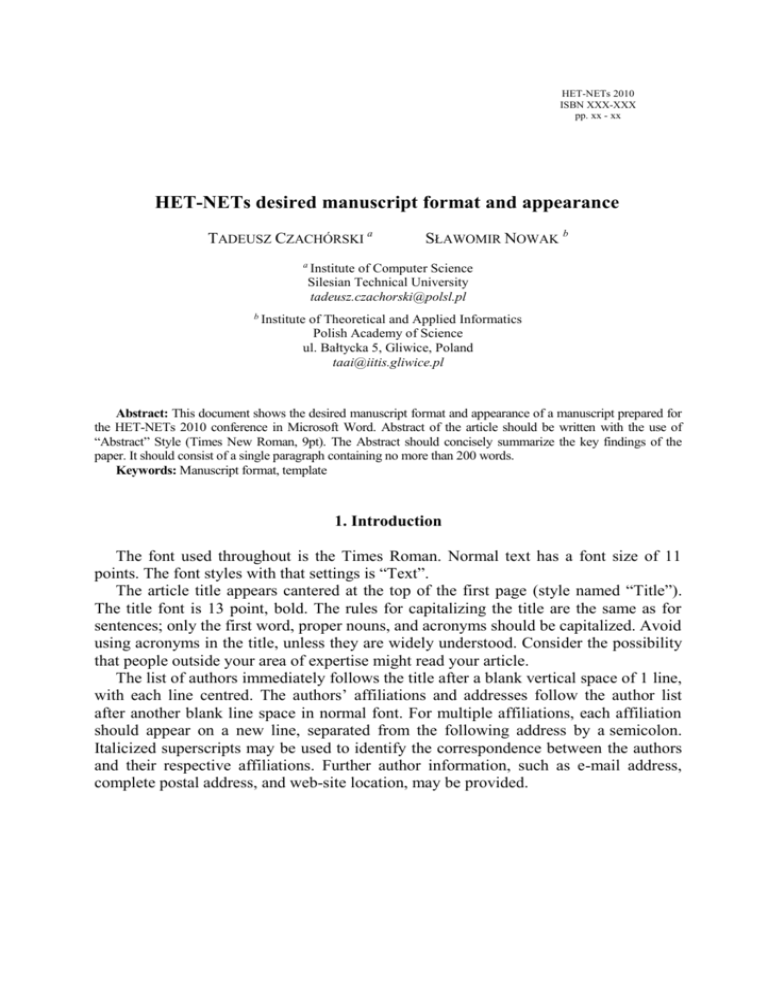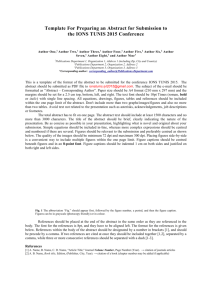Theoretical and Applied Informatics
advertisement

HET-NETs 2010 ISBN XXX-XXX pp. xx - xx HET-NETs desired manuscript format and appearance TADEUSZ CZACHÓRSKI a SŁAWOMIR NOWAK b a Institute of Computer Science Silesian Technical University tadeusz.czachorski@polsl.pl b Institute of Theoretical and Applied Informatics Polish Academy of Science ul. Bałtycka 5, Gliwice, Poland taai@iitis.gliwice.pl Abstract: This document shows the desired manuscript format and appearance of a manuscript prepared for the HET-NETs 2010 conference in Microsoft Word. Abstract of the article should be written with the use of “Abstract” Style (Times New Roman, 9pt). The Abstract should concisely summarize the key findings of the paper. It should consist of a single paragraph containing no more than 200 words. Keywords: Manuscript format, template 1. Introduction The font used throughout is the Times Roman. Normal text has a font size of 11 points. The font styles with that settings is “Text”. The article title appears cantered at the top of the first page (style named “Title”). The title font is 13 point, bold. The rules for capitalizing the title are the same as for sentences; only the first word, proper nouns, and acronyms should be capitalized. Avoid using acronyms in the title, unless they are widely understood. Consider the possibility that people outside your area of expertise might read your article. The list of authors immediately follows the title after a blank vertical space of 1 line, with each line centred. The authors’ affiliations and addresses follow the author list after another blank line space in normal font. For multiple affiliations, each affiliation should appear on a new line, separated from the following address by a semicolon. Italicized superscripts may be used to identify the correspondence between the authors and their respective affiliations. Further author information, such as e-mail address, complete postal address, and web-site location, may be provided. 2 2. Parts of manuscript The manuscript should be logically divided into sections. The body of the paper consists of numbered sections that present the main findings. Each sections should be preceded by numbered heading. As a heading the “subtitle” style should be used (Times New Roman, 11 points, bold). 2.1 Subsections Subsections have to be preceded by sub-heading written with Times New Roman, 10 points, bold (the Subsections’ style). The first word of a subtitles, subsections and sub-subsection heading is capitalized. The rest of the heading is not capitalized, except for acronyms and proper names. 2.1.1 Sub-subsections The sub-subsection heading is centered and its font is 10 point, bold. Capitalize as for sentences. Fig. 1. Figure captions are used to label the figure and help the reader understand the figure’s significance. The caption should be centred underneath the figure and set in 9-point font. One 1 Two 2 Result 123 Desc. Number Value - Tab. 1. Dummy table as an example 3. Figures and tables Figures are numbered in the order of their first citation. They should appear in numerical order and on or after the same page as their first reference in the text. Figures, along with their captions, should be separated from the main text by at least 0.2 in. or 5 mm (or one normal text space line). Figure captions are centred below the 3 figure or graph. Figure captions start with the figure number in 9-point bold font, the text is in 9-point normal font, see for example Fig. 1. For table example, see Tab.1. 4. Equations Equations may appear in line with the text, if they are simple, short, and not of major importance; e.g., β = b/r. Important equations appear on their own line. Such equations are centred. Equations are considered to be part of a sentence and should be punctuated accordingly. In order to refer to a specific equation, equations should be numbered in numerical order. Numbers appear on the right hand side of the equation. For example: t q 1 1 t , q mOX g iNR p OX i t q , (1) where OX denotes OR or OM. 3. References The References section lists books, articles, and reports that are cited in the paper. It does not have a section number. The references are numbered in the order in which they are cited. Examples of the format to be followed are given at the end of this document. References [1] Balthrop J., Esponda F., Forrest S., Glickman M.: Coverage and Generalization in Artificial Immune System. in Proc. Genetic Evolutionary Computation Conf., 2002. [3] Chao D., Forrest S.: Information Immune System. In Proceedings of the First International Conference on Artificial Immune Systems, 2002. [4] Esponda F., Forrest S., Helman P.: A Formal Framework for Positive and Negative Detection Schemes. IEEE Transactions on Systems, Man, and Cybernetics – Part B: Cybernetics, 34(1), pp. 357-373, 2004. [5] Hightower R., Forrest S., Perelson A.: The Baldwin Effect in the Immune System: Learning by Somatic Hypermutation. In R. K. Belew and M. Mitchell, editors, Individual Plasticity in Evolving Populations: Models and Algorithms. Addison-Wesley, pp. 159-167, 1996.











